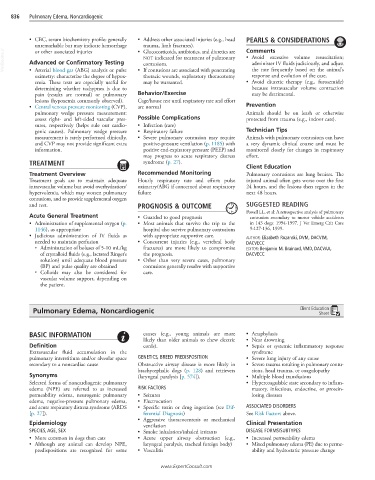Page 1666 - Cote clinical veterinary advisor dogs and cats 4th
P. 1666
836 Pulmonary Edema, Noncardiogenic
• CBC, serum biochemistry profile: generally • Address other associated injuries (e.g., head PEARLS & CONSIDERATIONS
trauma, limb fractures).
unremarkable but may indicate hemorrhage • Glucocorticoids, antibiotics, and diuretics are Comments
VetBooks.ir Advanced or Confirmatory Testing NOT indicated for treatment of pulmonary • Avoid excessive volume resuscitation;
or other associated injuries
administer IV fluids judiciously, and adjust
contusions.
• Arterial blood gas (ABG) analysis or pulse
response and evolution of the case.
thoracic wounds, exploratory thoracotomy
oximetry: characterize the degree of hypox- • If contusions are associated with penetrating the rate frequently based on the animal’s
emia. These tests are especially useful for may be warranted. • Avoid diuretic therapy (e.g., furosemide)
determining whether tachypnea is due to because intravascular volume contraction
pain (results are normal) or pulmonary Behavior/Exercise may be detrimental.
lesions (hypoxemia commonly observed). Cage/house rest until respiratory rate and effort
• Central venous pressure monitoring (CVP), are normal Prevention
pulmonary wedge pressure measurement: Animals should be on leash or otherwise
assess right- and left-sided vascular pres- Possible Complications protected from trauma (e.g., indoor cats).
sures, respectively (helps rule out cardio- • Infection (rare)
genic causes). Pulmonary wedge pressure • Respiratory failure Technician Tips
measurement is rarely performed clinically, • Severe pulmonary contusion may require Animals with pulmonary contusions can have
and CVP may not provide significant extra positive-pressure ventilation (p. 1185) with a very dynamic clinical course and must be
information. positive end-expiratory pressure (PEEP) and monitored closely for changes in respiratory
may progress to acute respiratory distress effort.
TREATMENT syndrome (p. 27).
Client Education
Treatment Overview Recommended Monitoring Pulmonary contusions are lung bruises. The
Treatment goals are to maintain adequate Hourly respiratory rate and effort; pulse injured animal often gets worse over the first
intravascular volume but avoid overhydration/ oximetry/ABG if concerned about respiratory 24 hours, and the lesions then regress in the
hypervolemia, which may worsen pulmonary failure next 48 hours.
contusions, and to provide supplemental oxygen
and rest. PROGNOSIS & OUTCOME SUGGESTED READING
Powell LL, et al: A retrospective analysis of pulmonary
Acute General Treatment • Guarded to good prognosis contusion secondary to motor vehicle accidents
• Administration of supplemental oxygen (p. • Most animals that survive the trip to the in 143 dogs: 1994-1997. J Vet Emerg Crit Care
1146), as appropriate hospital also survive pulmonary contusions 9:127-136, 1999.
• Judicious administration of IV fluids as with appropriate supportive care. AUTHOR: Elizabeth Rozanski, DVM, DACVIM,
needed to maintain perfusion • Concurrent injuries (e.g., vertebral body DACVECC
○ Administration of boluses of 5-10 mL/kg fractures) are more likely to compromise EDITOR: Benjamin M. Brainard, VMD, DACVAA,
of crystalloid fluids (e.g., lactated Ringer’s the prognosis. DACVECC
solution) until adequate blood pressure • Other than very severe cases, pulmonary
(BP) and pulse quality are obtained contusions generally resolve with supportive
○ Colloids may also be considered for care.
vascular volume support, depending on
the patient.
Pulmonary Edema, Noncardiogenic Client Education
Sheet
BASIC INFORMATION causes (e.g., young animals are more • Anaphylaxis
likely than older animals to chew electric • Near drowning
Definition cords). • Sepsis or systemic inflammatory response
Extravascular fluid accumulation in the syndrome
pulmonary interstitium and/or alveolar space GENETICS, BREED PREDISPOSITION • Severe lung injury of any cause
secondary to a noncardiac cause Obstructive airway disease is more likely in • Severe trauma resulting in pulmonary contu-
brachycephalic dogs (p. 128) and retrievers sions, head trauma, or coagulopathy
Synonyms (laryngeal paralysis [p. 574]). • Multiple blood transfusions
Selected forms of noncardiogenic pulmonary • Hypercoagulable state secondary to inflam-
edema (NPE) are referred to as increased RISK FACTORS matory, infectious, endocrine, or protein-
permeability edema, neurogenic pulmonary • Seizures losing diseases
edema, negative-pressure pulmonary edema, • Electrocution
and acute respiratory distress syndrome (ARDS • Specific toxin or drug ingestion (see Dif- ASSOCIATED DISORDERS
[p. 27]). ferential Diagnosis) See Risk Factors above.
• Aggressive thoracocentesis or mechanical
Epidemiology ventilation Clinical Presentation
SPECIES, AGE, SEX • Smoke inhalation/inhaled irritants DISEASE FORMS/SUBTYPES
• More common in dogs than cats • Acute upper airway obstruction (e.g., • Increased permeability edema
• Although any animal can develop NPE, laryngeal paralysis, tracheal foreign body) • Mixed pulmonary edema (PE) due to perme-
predispositions are recognized for some • Vasculitis ability and hydrostatic pressure change
www.ExpertConsult.com

